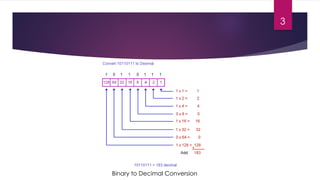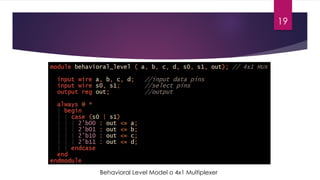Basics of Digital Design and Verilog
- 1. Digital Design & Verilog PRITHIVIRAJ. R, RITHIK NAMBIAR SRMIST, KTR.
- 2. Digital Systems u The foundation of all digital systems is binary numbers. u The binary representation has only two digits - 0 & 1. u Binary representation simplifies the design process and the circuitry itself. u It also provides a higher efficiency and smaller area/footprint. u The mathematics/algebra of binary numbers is called Boolean algebra. u Basic Boolean operations are implemented as a circuit/hardware in the form of logic gates. u Boolean algebra is used to design, simplify and analyze digital circuits. 2
- 3. Binary to Decimal Conversion 3
- 4. Logic Gates u It is the building block of all digital systems. u They implement the basic Boolean operations like AND, OR, NOT, XOR, etc. 4
- 5. Combinational Circuits u The output depends only on a combination of the present inputs. u Because of its dependence only on the present inputs, there is no feedback loop involved. u Examples include adders, multipliers, multiplexers, encoders, PLA, PLDs, etc. 5
- 6. Classification of Combinational Circuits 6
- 7. Sequential Circuits u Sequential Circuits the inputs depend on present as well as past inputs. u Sequential Circuits involve combinational blocks of logic and memory elements. u Examples include flip flops, FSM, RAM, etc. u Sequential Circuits are of two types: u Synchronous: They output changes are synchronized to edges of the clock (positive/rising edge or negative/falling edge) u Asynchronous: The output changes are triggered by the value of the clock(high or low), i.e., it is level sensitive. 7
- 8. 8 Asynchronous vs Synchronous Circuits – Timing Diagram
- 9. Finite State Machines (FSMs) u Its is generally used to control the behavior of systems and dataflow paths. u It is typically implemented in control units in the digital system. u It consists of multiple states, with each state being associated with a particular function or condition. u Eg. The system may go into low power mode when it is in ‘IDLE’ state and so on. u Depending on the state, different events/functions may be triggered. u Eg. When registers are full, the FSM can enter the ‘OVERLOAD’ state. Upon entering the OVERLOAD state, we can force the processor to put a hold on any future instructions to be executed until any registers are freed up. u There are two types of FSMs, Moore and Mealey. 9
- 10. 10 An FSM used to control the Data Link Layer of a PCIe Gen3 Link
- 11. Modern Digital Design u Modern Digital Design uses the concept of Datapath and Control Units. u The Datapath include functional blocks like ALUs. u The Control Units are typically implemented as FSMs. 11
- 12. 12 An Example of Datapath and Control Unit of a Processor
- 13. Verilog u During the early days of IC Design, engineers drew the circuits by hand. u This was a very difficult, complex, time consuming and error prone process. u VHDL was introduced in order to simplify this process. u The idea behind this is that the designer will “describe” the circuit using the HDL and the tools would infer a circuit that matches the designers intent. u Verilog was later designed in order to make the Hardware Description Language (HDL) more robust. 13
- 14. Verilog vs Conventional Programming Languages u Verilog is used to describe hardware, while programming languages are instructions for the hardware to do certain tasks. u Verilog is a concurrent(parallel) language. u The above code would infer two separate “AND” logic gates, while a similar statement in C++ would merely “and” the values of the variables. u In C++, the value of ‘A’ will be calculated first and then the value of ‘D’ will be calculated 14
- 15. Types of Modelling: u There are three types of modelling in Verilog: u Gate Level Modelling u Behavioral Modelling u Dataflow Modelling u Switch Level Modelling u RTL or Register transfer level is a mixture of behavioral and dataflow modelling that is used for designing synthesizable circuits. u RTL models the dataflow between registers and logical operations performed on the data. 15
- 16. Gate Level Modelling u It is practically the lowest level of abstraction as switch level is rarely used. u It is used to implement modules in the lower levels of hierarchy like adders, multipliers, etc. u Here the connection between the pins of the logic gates are manually specified. u Netlist obtained from synthesis tools are generally gate level models in Verilog. 16
- 17. A NAND gate designed using AND & NOT gates using gate level modelling in Verilog. 17
- 18. Behavioral Level Modelling u It is one of the highest level of abstraction provided by Verilog. u Procedural blocks and ‘reg’ variables are used the describe the behavior of the intended hardware. u Other statements like case, if, loops are used to model the behavior of the hardware. u It is not necessarily synthesizable. 18
- 19. Behavioral Level Model o 4x1 Multiplexer 19
- 20. Dataflow Modelling u This involves the use of operators to model the flow of data in the digital system, mainly using assign statements. u It is mainly used for designing combinational circuits. u It is always synthesizable. 20
- 21. 2x1 Multiplexer using Dataflow Modelling 21
- 22. Switch Level Modelling u This is the lowest level of modelling in Verilog. u It is similar to gate level modelling except that connections between the pins of the transistor is specified(like gate, drain ,etc.) u It involves the use of transistor primitives. 22
- 23. NOT gate using Switch Level Modelling 23
- 24. References u Morris Mano Digital Design 5th edition u www.chipverify.com u www.asic-world.com u PCI Express Technology 3.0 - Mindshare 24
- 25. Thank You 25
























